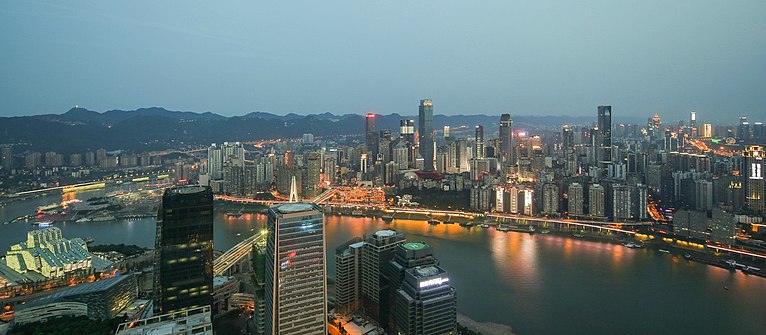Chongqing is the largest municipality in
southwest China. It is a modern port city on the upper reaches of the Yangtze
River at the confluence of the Yangtze and Jialing Rivers. With an area of 31,
800 square miles (82,400 square kilometers), it shares borders with provinces
of Hubei, Hunan, Guizhou, Sichuan, and Shaanxi.
As China’s fourth municipality after Beijing, Shanghai, and Tianjin, Chongqing has maintained rapid economic development while preserving a wonderful natural environment.
Known as the 'Mountain City', it has a wavy terrain and encompasses a wealth of water reserves, mineral resources, dense forests, and abundant flora and fauna.
The city attracts visitors from home and abroad for its natural wonders and cultural heritage. As a common starting port for the Yangtze River cruise, tourists can go for a downstream tour to the magnificent Three Gorges.
As China’s fourth municipality after Beijing, Shanghai, and Tianjin, Chongqing has maintained rapid economic development while preserving a wonderful natural environment.
Known as the 'Mountain City', it has a wavy terrain and encompasses a wealth of water reserves, mineral resources, dense forests, and abundant flora and fauna.
The city attracts visitors from home and abroad for its natural wonders and cultural heritage. As a common starting port for the Yangtze River cruise, tourists can go for a downstream tour to the magnificent Three Gorges.
- Yuzhong District (渝中区, or "Central Chongqing District"), the central and most densely populated district, where government and international business offices and the city's best shopping are located in the district's Jeifangbei CBD area. Yuzhong is located on the peninsula surrounded by E-ling Hill, Yangtze River and Jialing River.
- Jiangbei District (江北区, or "River North District"), located to the north of Jialing River.
- Shapingba District (沙坪坝区), roughly located between Jialing River and Zhongliang Mountain.
- Jiulongpo District (九龙坡区), roughly located between Yangtze River and Zhongliang Mountain.
- Nan'an District (南岸区, or "Southern Bank District"), located on the south side of Yangtze River.
- Dadukou District (大渡口区)
- Banan District (巴南区, or "Southern Chongqing District"). Previously called Ba County, and changed to the current name in 1994. Its northern area merged into central Chongqing, and its capital town Yudong is a satellite city of Central Chongqing.
- Yubei District (渝北区, or "Northern Chongqing District"). Previously called Jiangbei County, and changed into the current name in 1994. Its southern area merged into Central Chongqing, and the capital town Lianglu Town is a satellite city of Central Chongqing.
- Beibei District (北碚区), a satellite city northwest of Central Chongqing.

Panorama of the Chongqing Skyline, taken from Jiangbeizui CBD in 2015
Chongqing’s industrial competitiveness has been ranked sixth in China. It is estimated that information industry will become one of Chongqing’s pillar industries in the 11th Five-Year Plan. Chongqing’s GDP in 2008 reached RMB509.67 billion. The GDP growth in 2008 ranked the third in West China’s eleven provinces and ranked the fifth nationwide. The growth was mostly contributed by the industrial sector. The “One-hour Economic Circle” of Chongqing accounted for 78 percent of its total GDP. Chongqing’s used FDI saw a remarkable 152 percent increase in 2008.
Chongqing is China’s fourth largest center for motor vehicle production. The municipality is expected to turn out 2.6 million vehicles a year by 2020, an output that could account for as much as 15 percent of the national total. In 2008, it produced 780,000 vehicles, marking an annual increase of 25 percent. The industry is aiming to expand overseas and to outsource production of cars or components.
Chongqing is also one of the biggest iron and steel production centers, and an important aluminum production base. The manufacturing sector is also in good health. There are more than 10,000 factories with fixed assets of over RMB73 billion. In 2005, a number of prominent domestic appliance manufacturers, including Haier, Midea and Gless, relocated their factories from coastal provinces to Chongqing. It reportedly costs RMB100 less to produce an air-conditioning unit in Chongqing than it does in those provinces.
Chongqing is very open to FDI, FIEs and foreign trade. Global Fortune 500 companies with operations in the municipality include Danone, Carrefour, HSBC, Ericsson, Honda and Ford. Trade has also experienced significant growth. Despite the financial crisis, exports in 2008 still saw a 26.9 percent increase, though it was lower than the growth in 2007. Major export items include motorcycles, automobiles, auto parts, chemicals, pharmaceuticals, agricultural products and light industrial goods. Imports increased by 29.6 percent, leaving the municipality with a trade surplus of US$1.92 billion. The private sector accounted for 40 percent of the local economy, a proportion that is expected to reach 60 percent by 2014.